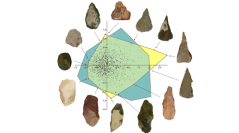

 Comptes Rendus Palevol
18 (5) - Pages 555-567
Comptes Rendus Palevol
18 (5) - Pages 555-567The nature, extent and causes of shape variation within and between Acheulean handaxe assemblages represent one of the most heavily theorised aspects of Lower Palaeolithic archaeology. To date, however, handaxe shape variation has only ever been studied within an artefact-based comparative context. Here, the 2D and 3D shape of 698 Acheulean handaxes, selected from ten assemblages, is contextualised within a theoretically possible range of forms defined by two intentionally highly diverse modern replica biface sets. Results demonstrate that handaxe artefacts are highly diverse in their 2D plan-view shape, displaying near complete overlap with the shape space of the intentionally diverse replica tools, along with similar levels of variation. The 3D shape of handaxe artefacts, however, displays much stronger form limitations, occupying under 50% of the shape space created by the replica bifaces. Principally, flat and more ‘tabular’ handaxe forms that display low thickness to width ratios were revealed as absent from the archaeological record. It is argued that while there is considerable diversity and variability in the shape of Acheulean handaxe artefacts, their form is nonetheless restricted by strong material volume and ‘refinement’ limits.
Lower Palaeolithic, Acheulean, LCT, Morphology, Relative thickness, Biface